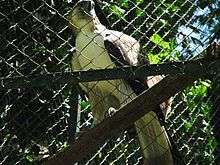Pag-asa (eagle)
Pag-asa (hatched January 15, 1992) is a male Philippine eagle and the first of its species to be bred and hatched in captivity.[1]
 Pag-asa in 2007 | |
| Species | Pithecophaga jefferyi |
|---|---|
| Sex | Male |
| Hatched | January 15, 1992 Philippine Eagle Center, Davao City |
| Nation from | Philippines |
| Known for | First Philippine eagle to be bred and hatched in captivity |
| Owner | Philippine Eagle Foundation |
| Offspring | 1 (Mabuhay) |
Conception
Pag-asa bred by a team of the Philippine Eagle Conservation Program Foundation (PECPF; now Philippine Eagle Foundation) led by executive director Dennis Salvador and camp manager Domingo Tanada.[2] Pag-asa is a result of 14 years of research.[3]
Pag-asa was bred through artificial insemination and was hatched through combined artificial and natural incubation technique taught by the World Center For Birds of Prey. The animal was the first offspring of Philippine eagles Diola and Junior. Then 29-year-old Diola, laid the egg of Pag-asa and Junior found in Agusan, was the sperm donor. The egg was placed under Diola for 12 days before it was transferred to an incubator. According to the PECPF, the breeding technique improved the hatchability of the egg by as much as 30 percent.[2]
Hatching
Pag-asa was hatched at 10:40 pm PST on January 15, 1992 at the Philippine Eagle Center[4] in Barangay Malagos at the Calinan district in Davao City and was the first of its kind to be successfully bred and hatched in captivity.[1] Hatched four days earlier than expected,[2] it weighed 134.6 grams (4.75 oz) at its hatching.[2] The chick had a hard time getting out of its egg and a PECPF staff member had to crack open the egg.[3]
Pag-asa was named after the Tagalog term for "hope" by PECPF team responsible for the eagle's breeding.[2] Awareness of conservation efforts on the endangered Philippine eagles increased after the hatching of Pag-asa.[5]
Then-Davao City Mayor Rodrigo Duterte declared Pag-asa's hatch day as Philippine Eagle Day or Pag-asa Day. Following Pag-asa's hatching, the Philippine Eagle Center was able to establish breeding and rearing protocols.[3]
Adult life
Pag-asa had its first chick on February 9, 2013 through artificial insemination. The chick hatched on 1:55 a.m PST from its egg which was laid by then 29-year old eagle, Kalinawan. It weighed 158 grams at its hatching. The chick was the first offspring of an eagle bred in captivity.[6] The chick was later named Mabuhay and determined to be female.[7][8]
Pag-asa is unsuitable to be released to the wild and will remain in captivity due to its dependence to its humans particularly its keeper, Eddie Juntilla, to whom it has imprinted on.[9]
References
- Regelado, Edith (15 January 2015). "Pag-asa, first Phl eagle bred in captivity, turns 23". The Philippine Star. Retrieved 15 January 2015.
- Milan, Vic (16 January 1992). "Rare Philippine Eagle hatches in captivity". Manila Standard. Retrieved 15 January 2015.
- Badilla, Joselle (15 January 2017). "Pag-asa: The silver eagle". Philippine Daily Inquirer. Retrieved 8 May 2018.
- "Philippine Eagle Foundation Sole Website". Retrieved September 2015. Check date values in:
|accessdate=(help) - Hidalgo, Fe San Juan (1999). Sustainable Development-every Filipino's Concern: Let's Help Save the Earth (1st ed.). Manila, Philippines: Rex Book Store. pp. 40–41. ISBN 9712327507. Retrieved 15 January 2015.
- Regelado, Edith (14 February 2013). "After 21 years, a chick for Pag-asa". The Philippine Star. Retrieved 15 January 2015.
- "Newly hatched PHL Eagle chick is named Mabuhay". GMA News. 1 March 2013. Retrieved 15 January 2015.
- Tejano, Ivy (15 February 2014). "Generation next waits in a cage". SunStar. Retrieved 15 January 2015.
- Manlupig, Karlos (17 January 2012). "A Philippine eagle's hope". Rappler. Retrieved 15 January 2015.